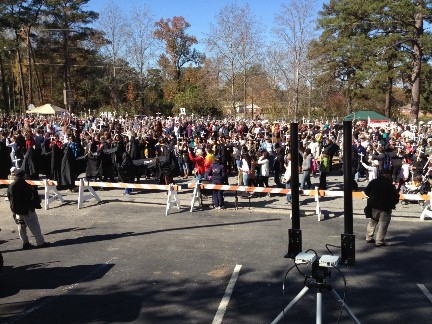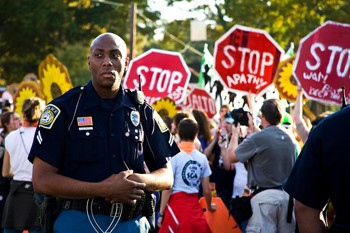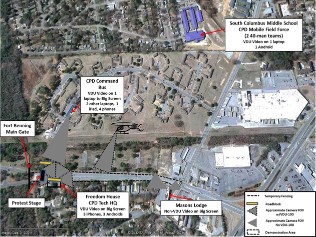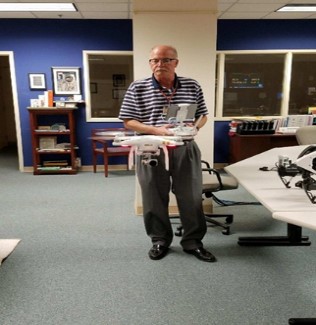.png)
I trust that the astute readers of this installment have noticed that the title of this article does not mention crowd control or crowd management with Small Unmanned Aircraft Systems (sUAS). While there can be influences exerted on crowds with sUAS we will never possess the volume of influence that a healthy Blackhawk or Jet Ranger can bring to the party, darn it. Fortunately, or unfortunately, depending on your mind set the use of rotor blast and noise intimidation on crowds is frowned upon in the United States and is pretty much outlawed, but we can still add a good dose of “force multiplier” to our team efforts at managing both unruly and peaceful crowd scenarios.

I have never asserted that sUAS will ever take the place of manned aviation and in many crowd monitoring operations, so you will likely be required to share the available airspace with manned aviation. While the “whirly birds” bring their special panache to the scene, sUAS stick pushers still have a meaningful contribution to make. With this in mind, our best tactic is to coordinate with our assets on the ground to give them the best intel that we can collect from near earth air. The ideas put forth here from your resident non-expert should give you ideas on how to conduct this operation safely and within the law.
Most of my experience with crowd monitoring comes from at least 15 years of overseeing the yearly protest of the School of Americas (SOA) at Fort Benning, GA. This was, up until last November, a mostly peaceful gathering of Priests, Nuns, college kids bussed down from up north for class credit, tee shirt vendors, flower children left over from the 60’s, and a few curious locals coming for the show. The crowd sized varied from 10 to 12 thousand in its early heyday to maybe 1,000 toward the end as enthusiasm dwindled. They did not show up at all last November and I have to believe this is the end of it.
To insure their safety and to insure their rights to peacefully gather and express their views we would provide a hundred or so of our police, sheriff’s deputies, and Fire and EMS personnel to watch intently from the sidelines. The festivities would span over two days and include speeches and protest music from the stage placed in front of the main gate of Ft. Benning and on the last day there would be a “presente” in which all of the names would be read of Latin Americans supposedly killed by the graduates from the SOA.

To help us keep a check on the crowd and keep those with ill intent at bay we always lined the protest area with ISP pole cameras feeding back into the makeshift command center and maintained careful checks at the entry gates to insure no weapons were smuggled in. BE ALERT. We always had a helicopter either on deck in the landing area unless it was making one of its several passes over the crowd and the surrounding area. We love our helicopter, but we are always reminded that chopper juice is expensive and the sUAS is much cheaper and quicker to launch. This article doesn’t lend itself to an in-depth reason for this yearly protest and anyone interested in the history and meaning can research it on line.
sUAS Flights Over People
Unless you specifically have a waiver to your COA that authorizes you to fly over people you are not legally allowed to do so. Even with the waiver I would give it serious consideration before spending very much time directly over crowds. Valuable intel and many worthwhile missions can be safely conducted from the periphery and should the crowd turn ugly you can always bend the mission envelope a little to see what you need to see. We stay off to the side and I recommend that you do the same. Drop your six pounds on a Nuns head from 200’ while she is singing Kumbaya and I bet ya’ll won’t fly drones again until George Jetson is President. Remember that I told you so.
I was asked recently by our City Manager to fly over a Martin Luther King Solidarity March and capture the magic moment when two groups of marchers converge from different directions and the march leaders shake hands in the middle of an intersection. He wanted me directly overhead of the two hand shakers when they came together. I was duty bound to inform him that I could video the hand shake from off to the side and not over the crowd and all I got was a, “Oh, that’s o.k. we’ll think of something else”. Between the lines I heard, “Really, all that money for neat toys and I can’t get a decent photo op. What good are you?”. Don’t be tempted to give in, it’s your license and your accident report to the FAA.
Video and Pictures
If you didn’t video it or take a photo of it….it didn’t happen. A good rule of thumb that we use is in these situations fire up the video recorder before taking off and shut it down when you land. You never know what you might see and often in the heat of the moment you will forget to activate the video camera. I have found that the cost in battery life to keep the video active is very negligible and is worth its weight in tacos if you happen to flumble into something. “Flumble”….that’s to stumble into something while flying.
If the well meaning activists or ACLU representative tells you that you can’t video the crowd or take pictures remind them that the accepted tenet of law is that a person has no reasonable expectation of privacy while in a public place. “Thank you very much for your input sir or ma’am".
At Least Two sUAS On Scene
Having two or more sUAS with accompanying pilots can do many things for you. With two birds you can conduct persistent surveillance. One in the air on station doing its thing while number two is on the pad ready to launch until bird one runs low on battery power. Have a pre-planned in and out procedure with at least 50’ of altitude separation when swapping out. If bird one is on station at 150’, have bird two come on station at 200’. Bird one backs out and starts home and bird number two drops to take its place at 150’. You get the idea. Pick your comfort zone of separation based on your preference or experience. Don’t get too fancy and try the Thunderbird thing with close passes. A mid air conflict in plain view of a couple of thousand people is difficult or impossible to live down.
“Big Bird, Little Bird”
Another option open to you with multiple sUAS is to fly your biggest, noisiest bird to a clearly visible location so that those in the crowd will see it. While those observant folks are very interested in it and are distracted by the big bird you can fly your smallest and quietest one to a 90 degree away vantage point and see what’s really going on. You might just see someone up to something nefarious. Magicians have done it for years, show them the right hand while the left hand does the trick. I don’t recommend trying this using the manned helicopter and a sUAs at the same time, but a quiet pass of the sUAS right after the big, big bird helicopter has cleared the area may accomplish the same thing.
Communications
For any of the coordinated maneuvers such as when two or more sUAs are in the air at the same time I strongly recommend that all pilots are within easy conversational reach of each other or they are in constant radio contact with each other, in a sterile cockpit environment, of course. Spotters should have radio contact as well on the sUAS communications net. Clearly identify each pilot and spotter with a distinct call sign. Keep it simple and easily identifiable. Each pilot should have a call sign readily identifiable to the sUAS. Example: Pilot one is flying a Phantom 3 Pro so he or she can be “Phantom 3” and their spotter can be “Phantom 3 Spot” etc.
Wires Are Every Where
In areas where crowds will be gathering for planned or unplanned actions please assume that there will be wires in the area. Powerlines, telephone lines, TV cable lines, guy wires or clothes lines, who knows. Hopefully, if this was a planned event you have done a pre-event recon of the area and have identified where these lines are and other points of interest that could unexpectedly terminate a flight. The FAA has a great video out there titled, “Flying In The Wire Environment”. In a zealous moment while studying for my Part 107 test I watched the video. I was so proud of myself that the next day I tracked down our helicopter pilot to tell him about by accomplishment. He smiled and recounted his instructor’s advice. Simply stated, “Wires are everywhere, don’t hit the wires”. Duh, I think that goes for trees too.

Crowd Counting
It is often beneficial to public safety entities and event planners to determine the estimated size of a crowd at various points during the event. This information can be used to better plan for future events or it may be used to justify expenditures on security personnel or to justify the number of public safety personnel and equipment brought to bear on the event. Most events, if they are planned or well controlled, will have made arrangements to count incoming attendees and often those leaving during the event will be counted and subtracted from the incoming total for a more accurate current count. sUAS can assist with acquiring an estimated event attendance at any point during the event as well as provide photo documentation of the estimated count. If this is a planned event sUAS pilots and or spotters can establish measured areas around the event venue during their pre-event recon. Light poles, building corners, trees or other immovable structures can be pre-identified and then measurements taken between them to construct an imaginary box of a known dimension. Once these landmarks have been identified and measured from point “a” to point “b” to point “c” to point “d” notate these figures in your notebook.
Launch the sUAS and fly over the box and take a photo including all four points and print this photo out when you are back at your home base. Use a pen or pencil to draw in the measured box for later comparison to photos taken during the event of the box with people in the box. By counting the number of persons in your box and making some simple calculations you should be able to arrive at an estimated number of persons attending the total event venue. It is always best to have multiple locations already defined since crowds do not equally disburse through the entire event venue area .
Don’t Wear A Flight Suit
Unless your department dress code requires you to wear a uniform I have found it best to dress like the crowd. You can move freely around the venue without people either stopping to talk to you about their latest “drone” adventures or purchase and in the worst case you will not be identified as the pilot of that cursed killer “eye in the sky”. If your ego will not allow that, wear something understated like your cool khaki 511 pants and an awesome polo shirt with your department logo. Besides, if you wear a flight suit the helicopter pilots will laugh at you.
Take Aways:
• Coordinate with your assets on the ground.
• Do not crash into the crowd, marchers, revelers, Nuns, Priests, or other religious figures. Unless you specifically have a waiver to your COA that authorizes you to fly over people you are not legally allowed to do so.
• Video everything, every flight.
• Fly with friends but communicate constantly.
• City officials who lack appropriate knowledge will probably ask you to do things with the sUAS that are not appropriate or illegal. Don’t be tempted to give in, it’s your license and your accident report to the FAA.
• It’s not being sneaky, it’s using psychology.
• Do not fly into powerlines, telephone lines, guy wires, clothes lines, trees or other aircraft. Wires are everywhere.
• If members of the crowd you are monitoring tell you that you can’t video them, politely remind them that accepted tenet of law is that a person has no reasonable expectation of privacy while in a public place.
• Do your homework. Recon the area ahead of time if it is a planned event.
• Crowd counts are estimates.
• Do not wear a flight suit.
Until next installment, “Out of the clear blue of the western sky comes Sky King!” Nah, it’s just a drone.
endnotes:
1. School of the Americas Watch
2. For a much more detailed explanation of this concept please look up and read, “Up in the Air: Applying the Jacobs Crowd Formula to Drone Imagery” by Austin Choi-Fitzpatricka, Tautvydas Juskauskas. This is an almost academic approach to good common sense but it is still a much more authoritative work than I can produce here. A word of caution though, the authors recommend positioning the sUAS directly over the crowd for a cleaner more accurate count. I’m pretty sure we’ve touched on this already and decided that it is just not a good idea. Shoot your photo from off to the side of the crowd.
About the Author

Deputy Chief Riley Land is the Deputy Director, Emergency Management and Homeland Security for the Columbus, Georgia Fire and Emergency Medical Services. He holds a Bachelor’s Degree in Business from Columbus College and has been employed with the Columbus Consolidated Government since 1992. He is a Certified Emergency Manager and is responsible for the emergency and disaster planning efforts for the city as well as the coordination of all city, state and federal resources that would respond to Columbus in the event of a major emergency or disaster.
Other duties include the responsibility for planning and conducting training exercises for the City of Columbus. Deputy Chief Land has received specialized training in emergency management, trained with the F.B.I. and the Treasury Department in explosives post blast investigation, trained with the Department of Energy in radiological response to weapons of mass destruction incidents as well as training in response to chemical and biological weapons with the Department of Defense in the Federal Domestic Preparedness program. He currently holds an FAA license for UAS remote pilot. He purchased the city’s first UAS in September of 2015 and organized the Emergency Management/Homeland Security UAS program for the city. The programs aviation assets now include a DJI Phantom 3 Pro and a DJI Inspire with visible light camera and FLIR.








